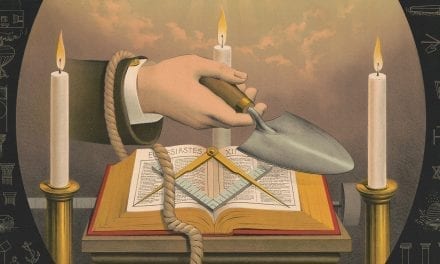FREEMASONRY AND THE MEDIEVAL CRAFT GUILDS
As Europe began to stabilize after the barbarian invasions and the fall of the Roman Empire, we begin to observe the formation of craft guilds. These organizations – which, like the collegia, offered their members mutual support, fellowship, communal banking, burial funds, etc. – were differentiated by their trade or specialization. Some of the crafts organized into guilds were those of the carpenters, painters, tanners, cobblers, apothecaries, candle makers and, of course, the stonemasons. While essentially secular in nature, these guilds were typically allied with the church and were often assigned a certain biblical narrative – such as the Creation and Fall of Man, the Fall of Lucifer, the Raising of Lazarus or the Last Judgement – to portray in mystery plays. Often, the subject matter was chosen in keeping with the guild’s craft, as was the case with the Feeding of the Five-Thousand (assigned to the baker’s guild) and the Building of Noah’s Ark (assigned to the carpenter’s guild).1 These dramatizations, apart from being a major contributing influence on later developments in theater and the cinema in general, could comfortably be presumed to be the direct antecedent to the extra-scriptural dramas performed in Freemasonry and its appendant bodies, as the stonemason-specific narratives performed by the Fraternity are centered upon those pertaining to the building of King Solomon’s Temple.
Workers in stone, who construct material edifices, in contradistinction to Speculative Masons, who build spiritual edifices.
– Source: Mackey’s Encyclopedia of Freemasonry
How the guilds were organized
The craft guilds were typically supervised by wardens, whose object it was to maintain standardization. These officers were elected annually and met in assemblies one to four times per annum. These assemblies were filled out by oath-bound members of the guild. As mentioned above, it is within the medieval craft guilds that we begin to see the hierarchical stratification of the workmen into the following classes (in ascending order): apprentices, journeymen (or, fellow crafts), and masters. Though this system can be traced back to 1260 CE, it was in 1563 CE that the duration of apprenticeship was formally fixed at seven years, a duration that is still imposed to this day in some Masonic jurisdictions, such as Australia. An apprentice was to be compliant, faithful and of sound body. Upon his graduation to journeyman, or fellow of the craft, the apprentice was entitled to the privileges afforded that class and considered an equal – on the level, as it were. The passage from apprentice to journeyman was predicated on the completion of the workman’s masterpiece and/or examination by the wardens. Journeymen were free to travel and receive wages; they generally worked under various masters until, in some cases, they were able to open a shop of their own, take on apprentices and hire journeymen. It was thereby that the fellowcraft attained the title of master. In time, civil problems arose, particularly those between the greater guilds and the lesser artisanal guilds; issues also emerged regarding a proto-unionization which may have negatively affected quality and innovation in the crafts. Political criticism was levelled at the guilds arguing that they hindered free trade and advancing capitalism until, in England in 1835 CE, the privileges enjoyed by the craft guilds were permanently abolished by Parliament. Further industrialization forced artisans to find employment in the ever-growing manufacturing industries.
Speculative Masonry begins
It was during the reign of the guild system that we begin to see the first legitimately documented cases of admission of speculative members in the operative craft of masonry – though there are a few earlier accounts of the admission of an accepted, or speculative masons, one of which may be found in the Cooke Manuscript dating from 1450 CE – making it the second-oldest of the Old Charges, next to the Halliwell Manuscript (aka, the Regius Poem, the composition of which has been dated sometime between 13903 and 1425 CE4 at Shropshire, England) – wherein it is stated that Prince Edwin, who has alternately been said to be King Athelstan’s (regnal years, 925-939 CE) son or brother and was not an operative mason, was said to have become a mason himself:
“And after that was a worthy kynge in Englond, that was callyd Athelstone, and his yongest son lovyd well the seiens of Gemetry, and he wyst well that hand craft had the praetyke of the seiens of Gemetry so well as masons; wherefore he drew him to eonsell and lernyd [the] practyke of that scions to his speculatyf. For of speculatyfe he was a master, and he lovyd well masonry and masons. And he bicome a mason hymselfe.”5
Judging by the regnal years of his father (or brother), King Athelstan, one could comfortably confine Prince Edwin’s masonic career to the 10th century CE – a very early date for accepted masonry, indeed. Certainly, laymen who were patrons of the craft were accepted into the fraternity as honorary masons, as it were; and these most likely for political reasons, coming from a royal bloodline or for their proficiency in the speculative aspects of the craft, such as displaying aptitude in geometry, astronomy, or some other member of the Seven Liberal Arts and Sciences. What trade secrets or Mysteries might be conveyed to one who had neither formally apprenticed nor produced a master’s piece is subject to conjecture. The operative guilds were reaching their nadir, however, and the ever-increasing number of accepted masons were poised to, in time, inherit custodianship of the ancient craft.
Decline of the guild system
Due largely to the Protestant Reformation, particularly in England, the guild system began to sharply decline throughout the first half of the 15th century; finally being suppressed by Henry VIII (regnal years, 1509-1547 CE). Cathedral building was halted, as these edifices were associated with the Papacy and therefore regarded as anathema by the Puritans. Job prospects for operative masons, then working independently, were bleak and many sought employment in private palatial construction for the affluent gentry and aristocracy. During this socially and politically tumultuous period, we begin to see the first documented instances of accepted masonry in the form of Lodge records reflecting speculative attendance among the Brethren. Lyon’s History of the Lodge of Edinburgh mentions minutes from that Lodge from 1600 CE naming one John Boswell, Laird of Auchinleck as a member. Other speculative masons in Scotland, particularly Edinburgh and Kilwininng Lodges, are named at this time, among them: William Schaw (1598 CE), Lord Alexander (1634 CE), his brother Sir Anthony Alexander (1634 CE), and Sir Alexander Strachan of Thornton (1634 CE) – these men also appearing to be relatively active in Lodge affairs.6 A short time later, in England, we encounter the more popular examples of speculative admission: Robert Moray (raised at Newcastle, 1641 CE) and Elias Ashmole (raised at Warrington, 1646 CE).
CITATIONS:
1.Gassner & Quinn, The Reader’s Encyclopedia of World Drama (England: middle ages), London: Methuen, 1969, pp. 203–204
- Haywood, Freemasonry and the Guild System, The Builder Magazine, Vol. 9, No. 11, 1923
- Halliwell
- Prescott, The Old Charges Revisited, from Transactions of the Lodge of Research No. 2429 (Leicester), 2006, Pietre-Stones Masonic Papers
- Matthew Cooke Manuscript, lines 611-626, 1450 CE, according to Hughan
- Haywood, How Operative Masonry Changed to Speculative Masonry, The Builder Magazine, Vol. 9, No. 11, 1923







